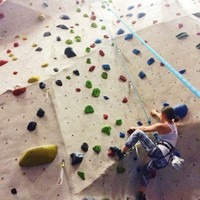Andrea Yonge and Ben Janson are Johns Hopkins University School of Medicine trainees who are working to become ophthalmologists, a competitive surgical specialty requiring focus and dedication. They are also avid rock climbers, which requires as much intellectual creativity and mental stamina as it does physical fitness and flexibility.
The first time I heard this, I was surprised — the one time I went climbing, I was physically and mentally exhausted at the end. For Janson and Yonge, however, climbing is a way to relax and rejuvenate. 
When they entered medical school, neither Janson nor Yonge planned to pursue ophthalmology — Janson was planning on surgery, while Yonge was considering neurology. However, as first-year medical students, they were inspired by their volunteer work with the Student Sight Savers Program, an outreach program that conducts monthly vision screenings under the guidance of the Wilmer Eye Institute faculty members.
Janson is currently applying to residency and worked with Shameema Sikder researching pterygium, a fleshy growth on the white of the eye. Yonge is taking a year off to work on Pradeep Ramulu’s research team, looking at assessment tools for falls in patients with glaucoma. Despite their full schedules, seeing patients and working on research, both Yonge and Janson regularly visit the rock gyms in Baltimore and dedicate hours pushing themselves to attempt more difficult and advanced climbs.
Janson first started climbing a few years ago at Acadia National Park, which inspired him and his wife to join some indoor climbing gyms in Baltimore. Over the past five months, they have climbed nearly every other day — switching between bouldering, climbing to lower heights without a harness and the more traditional, higher climbs — while Janson is still in school and interviewing for residency.
“You absolutely can have work-life balance as a medical student if you are wise about the time off, and rock climbing allows me to both exercise and have a leisure activity at the same time,” Janson says. Climbing for him is rejuvenating, especially after a difficult day. “There’s always another route that’s harder, and it’s continuous progression each time you climb. Any sort of stress or negative emotion can be applied toward pushing yourself hard on the rock wall.”
 Yonge started climbing more recently, when friends encouraged her to go “just once.” While on rotations, she could only climb on weekends, but since her research year started, she has upped the ante to several times per week. For Yonge, climbing is a combination of things. “It’s exercise, socializing and a bit of competition, both with yourself and among friends. All routes have a grade, so you’re constantly pushing yourself to do harder climbs.” On top of that, she cites a deeper connection between her leisure activity and her future career. “Problem-solving, precision and flexibility — in both senses — are valuable traits in both climbers and ophthalmologists,” she says. “I hope that my climbing skills will help me become a better ophthalmologist!”
Yonge started climbing more recently, when friends encouraged her to go “just once.” While on rotations, she could only climb on weekends, but since her research year started, she has upped the ante to several times per week. For Yonge, climbing is a combination of things. “It’s exercise, socializing and a bit of competition, both with yourself and among friends. All routes have a grade, so you’re constantly pushing yourself to do harder climbs.” On top of that, she cites a deeper connection between her leisure activity and her future career. “Problem-solving, precision and flexibility — in both senses — are valuable traits in both climbers and ophthalmologists,” she says. “I hope that my climbing skills will help me become a better ophthalmologist!”
Both Janson and Yonge plan to continue climbing, though in different respects. Janson plans to continue with indoor climbing, while Yonge has plans to expand to outdoor rock climbing and canyoneering. Even with busy future careers, they don’t see themselves taking a break from serious climbing anytime soon. As for my experience, after seeing them take it up as a serious hobby and still balance school and research, perhaps I’ll give climbing another try!